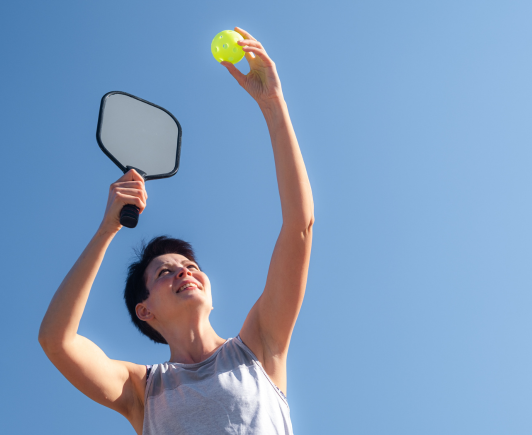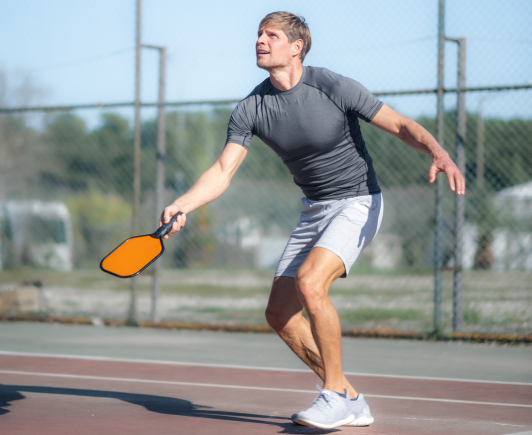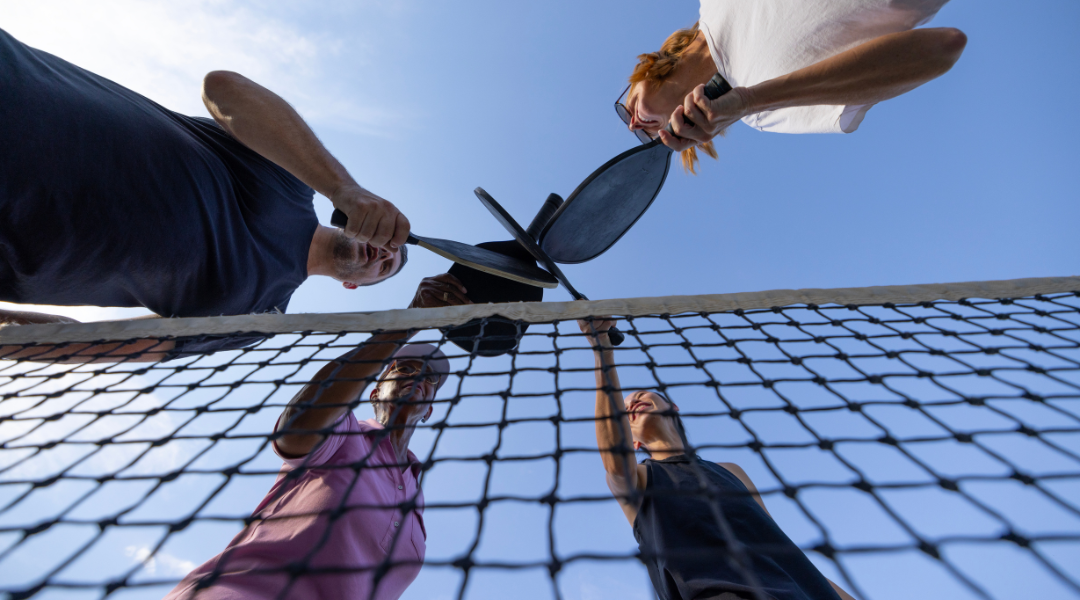Pickleball, a sport that blends elements of tennis, badminton, and ping-pong, has surged in popularity. Whether you’re a beginner looking to get into the game or an intermediate player aiming to enhance your skills, these top 10 pickleball tips will help you improve your game today.
The serve in pickleball is a crucial skill that initiates the point. It’s important to choose a serving style that feels natural for you. Whether you opt for a ground stroke style serve from the side of your body or a front-facing, bowling-style motion, maintaining consistency is essential.
Remember, you can only score points if your serve lands in the service box, so keep it simple. The purpose of the serve is to start the point, not necessarily to win it outright. However, as you improve and gain more control over your strokes, you can develop a more offensive serve.
For beginners, practicing a deep serve is advisable. A deep serve keeps your opponent at the baseline longer, while a short serve may prematurely invite them to a more advantageous position on the court. Use a short serve sparingly, only if you believe your opponent won’t reach it. To achieve depth in your serve, use a firm grip, keep the ball slightly closer to your body to avoid overreaching, engage your legs, and complete your swing. Focus on hitting your intended target area rather than on generating maximum power, as consistency is key to a successful serve.
A strong return can effectively transfer the pressure back to the server. Try to direct your returns deep into your opponent’s court, ideally targeting their backhand side. This strategy not only gives you additional time to get into position for the next shot but also starts to shape the point in your favor. A powerful return isn’t always about speed; a medium-paced return with a bit more arc can help you advance to the net more quickly.
If you find yourself frequently caught in the transition area and unable to move forward, it might be due to overly fast returns. For maximum depth on your return, maintain a firm grip, use a dynamic spring from your legs, and complete your swing. Your hips should face the ball, and you should step toward it based on your intended target area.
Shots down the line will require a larger step toward the ball, while diagonal shots need a smaller step, allowing more space for your paddle to follow through. Always keep your eyes on the ball and adjust your footwork to position the ball within your optimal strike zone.
After making your return, always move toward the net in the direction of the ball you’ve hit, and remember to execute a split step and pause when your opponent hits the ball back, ensuring you’re ready for the next shot.
After a deep serve and a deep return of serve focus on using minimal backswing to maintain control over your shots. A minimal backswing helps keep the ball low and gives you more time to react. Always keep your eyes on the ball as you hit it, watching it meet your paddle and then shifting your gaze toward your target as the ball departs. Having a strategy for your shots is crucial for maintaining control during play.
If you’re uncertain about where to aim, target your opponent’s feet. This forces them to lift the ball, making it difficult for them to hit a strong return. Often, players pop the ball up when they react instinctively without a plan and focus on their opponent instead of the ball during the hit.
Dinking is a key part of pickleball strategy. These soft shots dropped just over the net into the non-volley zone, can force your opponent to hit upwards and create opportunities for you to attack. Practice various dinks during your games—forehand, backhand, down the line and cross-court.
The best basic dink strategy is to hit the ball to the same spot (preferable right between your opponent’s feet), by doing this you will be able to cover the court better and be more prepared for the pop ups when they happen. Remember after each shot you hit, you should be moving to follow your shot and lining up your paddle and toes to face the ball. By hitting to the same spot, you will stay in perfect position the play the next ball.
Don’t get too fancy with your dinks. Simply outlasting your opponents with consistency is the easiest way to get your opponents to make mistakes or pop the ball up to you.
Good footwork is essential in pickleball for reaching the ball and positioning yourself correctly to hit effective shots. If you think about a baseball, hitting the pitch in the perfect strike zone allows for a much better hit. Pickleball is very similar. If we are too close or too far away from the ball it will likely be a mis hit. By understanding the correct strike zone for each shot, you will cut down on errors.
You should try to be balanced while serving and returning; however, when hitting drops and dinks, the ball should be more in front of you. Practice lateral movements, quick forward dashes, and side steps to enhance your agility on the court. Advanced footwork for lateral motion at the baseline or at the NVZ line includes using a small step in the direction you are moving towards and a sliding motion by dragging your opposite foot. This will allow you to move faster and more efficiently.
When facing slams or drops shots, sliding your foot up or back is a great way to get your body in position while keeping your weight over the ball where it needs to be. Sliding your foot back to get back a drop shot keeps your upper body forward. This decreases pop ups and keeps your upper body on offense. When trying to get a slam back this helps to put the ball in a better strike zone allowing your hips to be towards the ball where they should be.


While powerful shots are important, accurate placement can be even more effective. For beginners and advanced beginners, aim for your opponent’s feet. This shot often gets popped up, placing you at an offensive advantage. It also doesn’t allow for your opponent to hit angles which are often tough to get. The more you hit over and over to the same spot, the more you will frustrate your opponent causing them to hit a rushed shot.
For more advanced players, try to exploit your opponent’s weaknesses while playing to your strengths. Playing a weaker player or using proper shot selection to open up the court will allow you to look for winning opportunities. Moving the ball around is only a good strategy if you have a reason for where you are hitting. For example: I hit 3 shots to the right side of the court getting the player on the left to over commit to the middle which now opened up a hole on the court to try and catch your opponent off guard and forcing an off-balance hit. Or I hit two super short low dinks to the player in front of me getting that player to lean in and bend over which makes them an easy lob target.
These are just two examples of moving the ball around. Try to avoid changing ball direction for nor reason. This will cause you to have to move to follow each shot making you feel more rushed and less ready when the ball comes back. Changing ball direction also increases your chances of missing. The degree of difficulty is higher.
The third shot drop is a crucial skill in pickleball. After the serve and return, aim to drop your third shot gently into the kitchen or non-volley zone. This shot gives you time to approach the net since this is meant to be a slower shot. It will allow you to advance for offensive net play, a dominant position in pickleball.
Net play dominates pickleball. The team or player that controls the net usually controls the game. Practice volleying from the net and use your presence at the net to intimidate and limit your opponent’s shot options.
Think of your opponent’s body like a traffic light. Chest and above is a green light, their mid-section is the yellow light and knees and below is a red light. Avoid giving your opponent green light balls. These are attackable and will start the SLAM game! Yellow light balls aren’t bad but by giving your opponent nothing but red-light balls will give them nothing to attack. Red light balls should land below your opponent’s knees, preferably at their feet. Shots hit low create popups and mistakes by your opponents.
The traffic light analogy can be used for both you and your opponent. When a ball is in your GREEN light area, you should attack it, ensuring that the TIP of your paddle remains higher than the ball. If the tip of your paddle drops to the level of the ball or below, especially on shots above your chest, you will likely pop the ball up. Keeping the tip above the ball allows you to strike downward, targeting your opponent’s feet. A green light ball is always an opportunity for an offensive shot!
When a ball is in your YELLOW zone, around your mid-section, you’re likely to execute a block volley or a reset shot. For these shots, your paddle tip should be parallel to the ball. Catch the ball gently on your paddle face while maintaining your gaze on it. Then, softly lower the paddle tip in a downward motion and gently push the ball in the direction you want it to go. Blocks can be soft, acting as a reset to take the pace off the ball, giving your opponent a difficult shot to return. Alternatively, they can be hit faster and crisper for a more offensive reset. Simply maintain a tighter grip and execute a quicker push motion.
The RED-light ball is hit at your feet and typically does not present an offensive opportunity. Respond to this challenging low ball by dinking it back or resetting it to your opponent’s feet, and wait for the next green light ball to attack. A pro tip: avoid looking at your opponent’s face when executing these shots. Doing so can inadvertently lead you to hit towards them and may also cause issues with your paddle positioning and body mechanics since you’re not focusing on the ball-paddle connection.
Lastly, the mental aspect of pickleball cannot be overstated. Maintain a positive, focused mindset throughout your games. Celebrate good shots, learn from mistakes, and keep a calm demeanor. Confidence goes a long way in improving your play and enjoying the game.
Improving at pickleball requires practice, strategic thinking, and a willingness to learn from every game. By focusing on these top 10 tips, you can enhance your skills, understand the game better, and become a formidable player on the court. Remember, the essence of pickleball lies in fun and camaraderie, so enjoy every moment on the court as you play your way to better skills. Pickleball is a lifetime sport that should bring lots of joy and fun to your life!
Have you had fun today?

IPTPA Master level pickleball pro, aiming to enhance the skills of players globally by making the game more enjoyable, effective, and fun.

One Response
Thank you for sharing this – I used to play tennis when I was young and would love to get into Pickleball. This is super helpful!